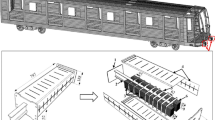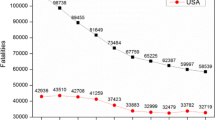Abstract
Crash-box is a significant part of automotive passive safety system and serves as a main energy absorption device in frontal impact scenario. In this paper, a novel crash-box integrating an outer thin-walled tube and an inner auxetic cellular core has been designed and comprehensively investigated under axial load. The impact simulation of the auxetic crash-box has been carried out, and the results show that introduction of the auxetic core can improve its energy absorption capacity without increasing too much peak impact force. Based on the sensitivity analysis, the effects of its geometric parameters on the crashworthiness performance have been studied. Finally, collaborative optimization of the auxetic crash-box has been performed to simultaneously improve its crashworthiness under the low-speed (15 km/h) and high-speed (40 km/h) impact cases. In the optimization procedure, the least square support vector regression (LS-SVR) method and an improved particle swarm optimization (IPSO) algorithm with time-varying coefficients have been utilized. The results demonstrate that the optimized crash-box can comprehensively improve the energy absorption and impact force characteristics effectively. The auxetic crash-box and the collaborative optimization approach provide extensive references for the application of auxetic structure in vehicle crashworthiness design.













Similar content being viewed by others
References
Alderson A, Rasburn J, Evans KE (2007) Mass transport properties of auxetic (negative Poisson’s ratio) foams. Phys Status Solidi B 244(3):817–827. https://doi.org/10.1002/pssb.200572701
Baroutaji A, Sajjia M, Olabi A (2017) On the crashworthiness performance of thin-walled energy absorbers: recent advances and future developments. Thin-Walled Struct 118:137–163. https://doi.org/10.1016/j.tws.2017.05.018
Booker AJ, Dennis JE, Frank PD, Serafini DB, Torczon V, Trosset MW (1999) A rigorous framework for optimization of expensive functions by surrogate. Struct Multidiscip Optim 17(1):1–13. https://doi.org/10.1007/BF01197708
Chan N, Evans KE (1997) Microscopic examination of the microstructure and deformation of conventional and auxetic foams. J Mater Sci 32(21):5725–5736. https://doi.org/10.1023/A:1018665617008
Chen DH (2011) Equivalent flexural and torsional rigidity of hexagonal honeycomb. Compos Struct 93(7):1910–1917. https://doi.org/10.1016/j.compstruct.2011.02.009
Chen TT, Zhang Y, Liu JM, Lu Y (2019) Theoretical analysis and crashworthiness optimization of hybrid multi-cell structures. Thin-Walled Struct 142:116–131. https://doi.org/10.1016/j.tws.2019.05.002
Cheng K, Lu ZZ, Wei YH, Shi Y, Zhou YC (2017) Mixed kernel function support vector regression for global sensitivity analysis. Mech Syst Signal Process 96:201–214. https://doi.org/10.1016/j.ymssp.2017.04.014
Duan Q, Jin T, Chen SJ, Shu XF (2016) Mechanical analysis of PA66 under combined shear–compression. Appl Phys A 123:365. https://doi.org/10.1007/s00339-017-0988-0
Etienne K (2012) Decade of action for road safety 2011–2020. Injury 43(1):6–7. https://doi.org/10.1016/j.injury.2011.11.002
Fang JG, Gao YK, Sun GY, Qiu N, Li Q (2015a) On design of multi-cell tubes under axial and oblique impact loads. Thin-Walled Struct 95:115–126
Fang JG, Gao YK, Sun GY, Zheng G, Li Q (2015b) Dynamic crashing behavior of new extrudable multi-cell tubes with a functionally graded thickness. Int J Mech Sci 103:63–73
Hu LL, Zhou ZM, Deng H (2018) Dynamic crushing response of auxetic honeycombs under large deformation: theoretical analysis and numerical simulation. Thin-Walled Struct 131:373–384. https://doi.org/10.1016/j.tws.2018.04.020
Khaw JFC, Lim BS, Lim LEN (1995) Optimal design of neural networks using the Taguchi method. Neurocomputing 7(3):225–245
Kim HC, Shin DK, Lee JJ, Kwon JB (2014) Crashworthiness of aluminum/CFRP square hollow section beam under axial impact loading for crash box application. Compos Struct 112:1–10. https://doi.org/10.1016/j.compstruct.2014.01.042
Kohar CP, Mohammadi M, Mishra RK, Inal K (2015) Effects of elastic–plastic behaviour on the axial crush response of square tubes. Thin-Walled Struct 93:64–87. https://doi.org/10.1016/j.tws.2015.02.023
Lakes RS, Elms K (1993) Indentability of conventional and negative Poisson’s ratio foams. J Compos Mater 27(12):1193–1202. https://doi.org/10.1177/002199839302701203
Lebaal N (2019) Robust low cost meta-modeling optimization algorithm based on meta-heuristic and knowledge databases approach: application to polymer extrusion die design. Finite Elem Anal Des 162:51–66. https://doi.org/10.1016/j.finel.2019.05.004
Lee SJ, Lee HA, Yi SI, Kim DS, Yang HW, Park GJ (2012) Design flow for the crash box in a vehicle to maximize energy absorption. Proc Inst Mech Eng D: J Automob Eng 227(2):179–200. https://doi.org/10.1177/0954407012451545
Liu WY, Wang NL, Luo T, Lin ZQ (2016) In-plane dynamic crushing of re-entrant auxetic cellular structure. Mater Des 100:84–91. https://doi.org/10.1016/j.matdes.2016.03.086
Miranda V, Teixeira-Dias F, Pinho-da-Cruz J, Novo F (2010) The role of plastic deformation on the impact behaviour of high aspect ratio aluminium foam-filled sections. Int J Non Linear Mech 45(5):550–561. https://doi.org/10.1016/j.ijnonlinmec.2010.02.005
Pyka G, Burakowski A, Kerckhofs G, Moesen M, Bael SV, Schrooten J, Wevers M (2012) Surface modification of Ti6Al4V open porous structures produced by additive manufacturing. Adv Eng Mater 14(6):363–370. https://doi.org/10.1002/adem.201100344
Pyrz M, Krzywoblocki M (2019) Crashworthiness optimization of front rail structure using macro element method and evolutionary algorithm. Struct Multidiscip Optim 60(2):711–726. https://doi.org/10.1007/s00158-019-02233-7
Qiu N, Gao YK, Fang JG, Feng ZX, Sun GY, Li Q (2015) Crashworthiness analysis and design of multi-cell hexagonal columns under multiple loading cases. Finite Elem Anal Des 104:89–101
Ratnaweera A, Halgamuge SK, Watson HC (2004) Self-organizing hierarchical particle swarm optimizer with time-varying acceleration coefficients. IEEE Trans Evol Comput 8(3):240–255. https://doi.org/10.1109/TEVC.2004.826071
Ren X, Das R, Tran P, Ngo TD, Xie YM (2018) Auxetic metamaterials and structures: a review. Smart Mater Struct 27(2):023001
Scarpa F, Bullough WA, Lumley P (2004) Trends in acoustic properties of iron particle seeded auxetic polyurethane foam. Proc Inst Mech Eng C J Mech Eng Sci 218(2):241–244. https://doi.org/10.1243/095440604322887099
Shiju SS, Asif S, Sumitra S (2017) Multiple kernel learning using composite kernel functions. Eng Appl Artif Intell 64:391–400. https://doi.org/10.1016/j.engappai.2017.06.026
Steiner M, Bourinet JM, Lahmer T (2019) An adaptive sampling method for global sensitivity analysis based on least-squares support vector regression. Reliab Eng Syst Saf 183:323–340. https://doi.org/10.1016/j.ress.2018.11.015
Sun GY, Tian XY, Fang JG, Xu FX, Li GY, Huang XD (2015) Dynamical bending analysis and optimization design for functionally graded thickness (FGT) tube. Int J Impact Eng 78:128–137
Sun DY, Shi Y, Zhang BQ (2018) Robust optimization of constrained mechanical system with joint clearance and random parameters using multi-objective particle swarm optimization. Struct Multidiscip Optim 58:2073–2084. https://doi.org/10.1007/s00158-018-2021-4
Sun GY, Deng M, Zheng G, Li Q (2019a) Design for cost performance of crashworthy structures made of high strength steel. Thin-Walled Struct 138:458–472. https://doi.org/10.1016/j.tws.2018.07.014
Sun GY, Wang Z, Yu H, Gong ZH, Li Q (2019b) Experimental and numerical investigation into the crashworthiness of metal-foam-composite hybrid structures. Compos Struct 209:535–547. https://doi.org/10.1016/j.compstruct.2018.10.051
Tsiptsis IN, Liimatainen L, Kotnik T, Niiranen J (2019) Structural optimization employing isogeometric tools in particle swarm optimizer. J Build Eng 24:100761. https://doi.org/10.1016/j.jobe.2019.100761
Wang ZG (2019) Recent advances in novel metallic honeycomb structure. Compos Part B 166:731–741. https://doi.org/10.1016/j.compositesb.2019.02.011
Wang CY, Li Y, Zhao WZ, Zou SC, Zhou G, Wang YL (2018a) Structure design and multi-objective optimization of a novel crash box based on biomimetic structure. Int J Mech Sci 138–139:489–501. https://doi.org/10.1016/j.ijmecsci.2018.01.032
Wang CY, Zou SC, Zhao WZ, Wang YL, Zhou G (2018b) Multi-objective explosion-proof performance optimization of a novel vehicle door with negative Poisson’s ratio structure. Struct Multidiscip Optim 58:1805–1822
Wang T, Wang LM, Ma ZD, Hulbert GM (2018c) Elastic analysis of auxetic cellular structure consisting of re-entrant hexagonal cells using a strain-based expansion homogenization method. Mater Des 160:284–293. https://doi.org/10.1016/j.matdes.2018.09.013
Wang T, Li Z, Wang LM, Ma ZD, Hulbert GM (2019) Dynamic crushing analysis of a three-dimensional re-entrant auxetic cellular structure. Materials 12(3):460. https://doi.org/10.3390/ma12030460
Wu SZ, Zheng G, Sun GY, Liu Q, Li GY, Li Q (2016) On design of multi-cell thin-wall structures for crashworthiness. Int J Impact Eng 88:102–117. https://doi.org/10.1016/j.ijimpeng.2015.09.003
Yang L, Harrysson O, West H, Cormier D (2012) Compressive properties of Ti–6Al–4V auxetic mesh structures made by electron beam melting. Acta Mater 60(8):3370–3379. https://doi.org/10.1016/j.actamat.2012.03.015
Yang L, Harrysson O, West H, Cormier D (2015) Mechanical properties of 3D re-entrant honeycomb auxetic structures realized via additive manufacturing. Int J Solids Struct 69-70:475–490. https://doi.org/10.1016/j.ijsolstr.2015.05.005
Yuan HL, Zheng JJ, Lai LL, Tang YY (2018) A constrained least squares regression model. Inf Sci 429:247–259. https://doi.org/10.1016/j.ins.2017.11.020
Zhang Y, Xu X, Wang J, Chen TT, Wang CH (2018) Crushing analysis for novel bio-inspired hierarchical circular structures subjected to axial load. Int J Mech Sci 140:407–431. https://doi.org/10.1016/j.ijmecsci.2018.03.015
Zhang Y, He N, Song XY, Chen TT, Chen HC (2020) On impacting mechanical behaviors of side fractal structures 146. https://doi.org/10.1016/j.tws.2019.106490
Zhou Q, Shao XY, Jiang P, Zhou H, Shu LS (2015) An adaptive global variable fidelity metamodeling strategy using a support vector regression based scaling function. Simul Model Pract Theory 59:18–35. https://doi.org/10.1016/j.simpat.2015.08.002
Zhou G, Ma ZD, Li GY, Cheng AG, Duan LB, Zhao WZ (2016) Design optimization of a novel NPR crash box based on multi-objective genetic algorithm. Struct Multidiscip Optim 54:673–684. https://doi.org/10.1007/s00158-016-1452-z
Zhou G, Zhao WZ, Li QQ, Shen WQ, Wang CY (2017) Multi-objective robust design optimization of a novel NPR energy absorption structure for vehicles front ends to enhance pedestrian lower leg protection. Struct Multidiscip Optim 56:1215–1224
Zhu GH, Wang Z, Cheng AG, Li GY (2017) Design optimization of composite bumper beam with variable cross-sections for automotive vehicle. Int J Crashworthiness 22(4):365–376. https://doi.org/10.1080/13588265.2016.1267552
Acknowledgments
This research was funded by the Fundamental Research Funds for the Central Universities, Grant number 309181B8809 and 30919011203; the Natural Science Foundation of Jiangsu Province, Grant number BK20190462; the National Natural Science Foundation of China, Grant number 51975295.
Author information
Authors and Affiliations
Contributions
Conceptualization, T.W. and Z.L.; methodology, T.W.; software, Z.L.; validation, G.M.H.; formal analysis, T.W.; investigation, T.W.; resources, Z.L.; writing—original draft preparation, T.W.; visualization, G.M.H.; supervision, L.W.; project administration, L.W.; funding acquisition, L.W.
Corresponding author
Ethics declarations
Conflict of interest
The authors declare that they have no conflict of interest.
Replication of results
All necessary data of modeled structure have been given in the text of the paper (e.g., geometry of the crash-box, material properties, simulation conditions). In chapter 4.1 and 4.3, the mathematical formulation of the IPSO, and corresponding coefficients were detailed.
Additional information
Responsible Editor: Qing Li
Rights and permissions
About this article
Cite this article
Wang, T., Li, Z., Wang, L. et al. Crashworthiness analysis and collaborative optimization design for a novel crash-box with re-entrant auxetic core. Struct Multidisc Optim 62, 2167–2179 (2020). https://doi.org/10.1007/s00158-020-02568-6
Received:
Revised:
Accepted:
Published:
Issue Date:
DOI: https://doi.org/10.1007/s00158-020-02568-6




